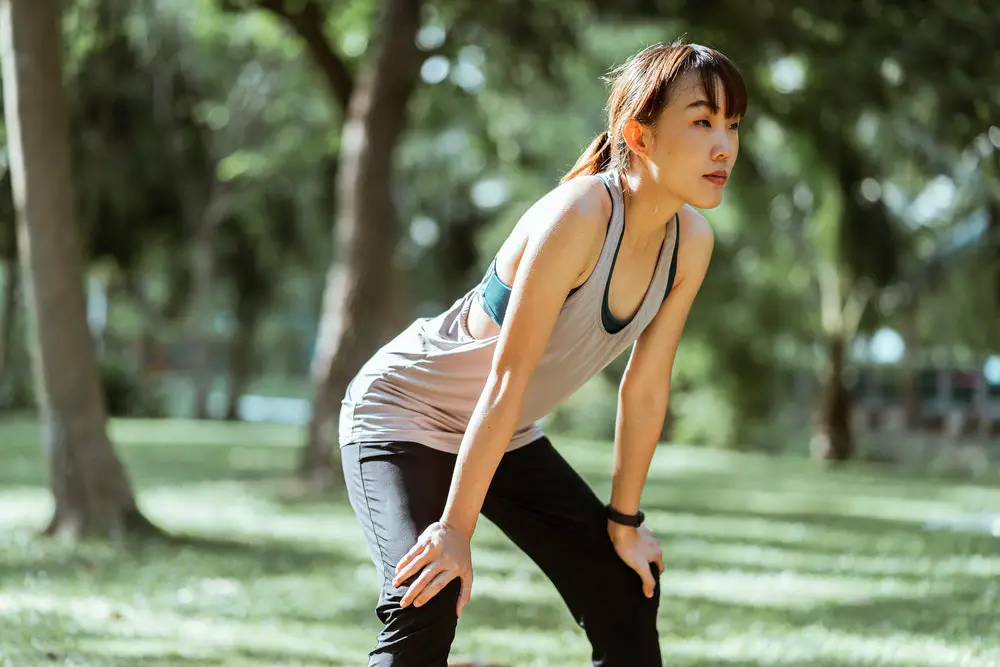This is a contentious issue amongst runners. Nobody, from Olympians down to school track and field runners, seems to be able to agree on whether bending over after a race is actually helpful.
However, anyone who has run any sort of distance knows that bending over feels natural and almost instinctive. Whether you’ve run for the bus or you’ve just done a cross-country race, you’ll be familiar with the feeling.

The bent over with hands on the knees position is one of two popular recovery positions. These positions are used by runners after a race to try and get more oxygen into their bodies.
During a race, your heart and lungs are working incredibly hard to keep supplying your muscles with oxygen. Your muscles are using more oxygen than normal because you’re asking them to work harder.
Your breathing rate increases because you need extra oxygen, and you need to remove the extra carbon dioxide that is created.
When the race is over, you’re still breathing harder and faster than normal because your muscles have been working in deficit. This means that they are owed some oxygen and have built up some carbon dioxide.
Over time, your breathing will go back to normal, but this can take a long time. This is why runners bend over.
When they bend over, it helps their body recover from the race because it allows them to get rid of the deficit and reduce their breathing rate.
The bent over position is particularly good at encouraging recovery because it gives the diaphragm more space to work.
The diaphragm is a thin muscle that sits at the base of your chest. It helps you breathe by contracting and relaxing.
When the diaphragm contracts, it pulls air into your lungs thanks to the vacuum it creates. When it relaxes, it expels air from your lungs.
By bending over, the diaphragm is naturally relaxed, this allows you to take deep breaths because the lungs are not inflated.
When you stand upright with your hands behind your head, the diaphragm is naturally contracted. This makes it harder to pull air into your lungs because they’re already partly inflated. It’s like trying to put more air in an inflated tire.
So, when you see runners bent over at the end of their race, they are simply trying to get more oxygen into their bodies. This oxygen is used by their tired muscles and helps to reduce their heart and breathing rates.
Is it Bad to Bend Over After Running?
There have been discussions and arguments about this for decades, but we seem to be getting closer to the scientific truth.
As it turns out, bending over after a race is not bad for you. In fact, it is better than standing tall and putting your hands behind your head.
It used to be believed that putting your hands behind your head and standing upright was the best way to recover after a race. Many coaches and parents would shout at their runners to stand up at the end of the race. In truth, many still do.
They believed that by standing upright, the lungs were elevated and open which made it easier to get air into the body.
The truth is quite different.
You see, when you stand up straight and put your hands behind your head, your back is rigid. More importantly, your rigid back makes your chest cavity rigid, and it causes your diaphragm to contract.
This means that even after you exhale air, your lungs stay partly inflated due to the position of your diaphragm and chest cavity. Ultimately, this leads to inefficient breathing. You can’t fully exhale, and you can only take in a small amount of air.
When you bend over, your diaphragm and chest is relaxed which lets you get the full use of your lungs via your diaphragm.
The other great thing about bending forward is that gravity helps your heart and lungs. By bending over, these organs are much lower. This means that the deoxygenated blood from your muscles finds it easier to return to your heart and lungs.
Once there it can dump the carbon dioxide, collect oxygen, and make its way back to the muscles.
Think about it, when you feel faint, you’re advised to put your head between your knees. Well, the same premise applies to recovering after a race.
All of this comes from a small study conducted on female soccer players. You can read the original paper here. In essence, they found that the athletes recovered faster when they placed their hands on their knees as opposed to behind their backs.
It was only a small study, but it is seen as the beginning of something bigger.
- How Many Calories Do You Burn Running a Marathon? - May 13, 2021
- Should You Run On An Empty Stomach? - May 12, 2021
- Which Exercise Is Best for Lungs? - May 11, 2021
